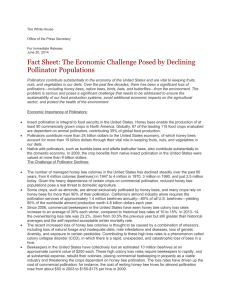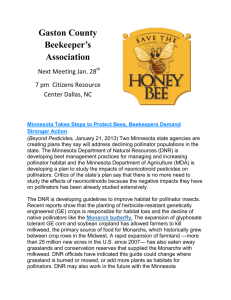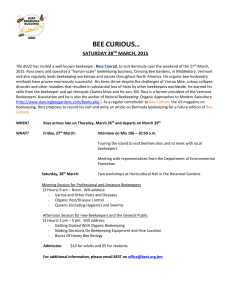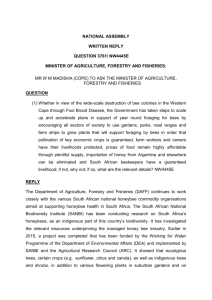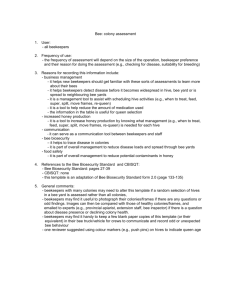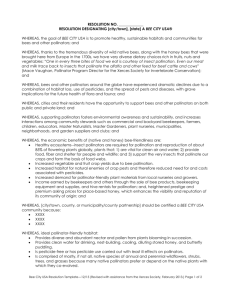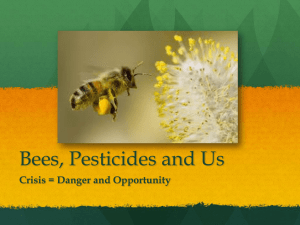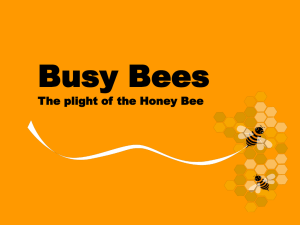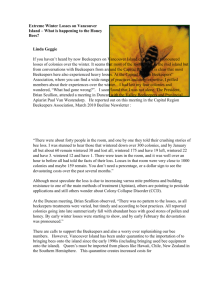Upper Rogue Pollinator Project
advertisement
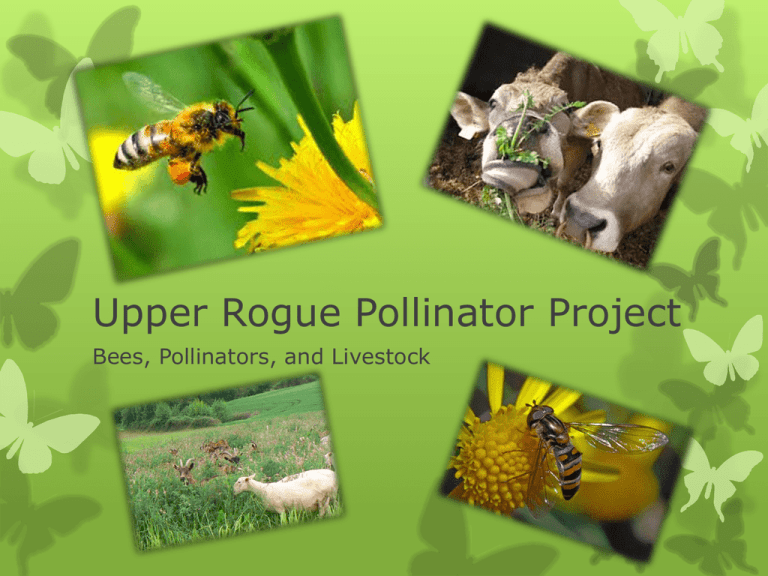
Upper Rogue Pollinator Project Bees, Pollinators, and Livestock When beekeepers can’t keep their bees alive inside the box, how does a colony like this - against all odds survive OUTSIDE the box? A Feral Colony Of Bees Could the reason be genetics? The Value of Honey Bees (more than just honey) More than just honey Pollinate more than 90 of the tastiest flowering crops we have – among them: Apples, nuts, avocados, soybeans, asparagus, broccoli, celery, squash and cucumbers Citrus fruit, peaches, kiwi, cherries, blueberries, cranberries, strawberries, cantaloupe and other melons One-third of the human diet comes from insectpollinated plants. The honeybee is responsible for 80 percent of that pollination. Even CATTLE, which feed on alfalfa and clover, depend on bees Demise of the Honey Bee? (Demise of Humanity?) Colony Collapse Disorder (CCD) and pollinator decline Main causes of colony collapse disorder are (according to most scientists): Nutritional stress Pathogens (mites, viruses and fungus) Pesticides and insecticides (especially neonicotinoids) Herbicides (destroy habitat) Fungicides have insecticidal toxic affects on pollinators (killing off important bee "gut" microbiota) Even adjuvants (so-called inert ingredients) in above chemicals The Effects of Pollinator Decline The success rate of beginning beekeepers is only 25%. Even advanced beekeepers suffer between 30% - 65% hive loss. Crops dependent on insect pollination are in decline (e.g., CA almonds). Who are we? Wild Bee International Teaching – Research – Development Standardized teaching system for beginning beekeepers and youth. Research stations to develop habitat and genetically superior bee stock while improving the sustainability of livestock production Ultimate goal: An enhanced future for our children and grandchildren Collaborate with OSU and SOBA. A Solution – The Upper Rogue Pollinator Project All pollinators in Jackson County are in peril. Farmers’ and cattle owners’ lifestyles are in danger. Local solution – enhanced genetics and improved habitat Uniqueness of Southern Oregon Upper Rogue Pollinator Project The Concept Collaboration among local farmers, cattle owners, beekeepers, scientists and researchers Promote improved livestock foraging within a self-sustaining ecosystem Focused on Upper Rogue River Basin Controlled honeybee environment Upper Rogue Pollinator Project The Mission Russian Queen Bee Establish a controlled beekeeping environment to . . . Breed a predominant, locally adapted and genetically advanced honeybee population while . . . Increasing the forage basis for livestock. Benefits Good For Bees - Good For Livestock: Sainfoins (Onobrychis) Eurasian perennial herbs of the legume family Extends throughout Europe as far north as southern Sweden Grows on grassland, agricultural land and wasteland; non-invasive Drought tolerant, winter-hardy and frost tolerant Blooms between June and September and pollinated by honey bees and solitary bees Superb forage for grazing animals - voluntary intake of sainfoin by cattle and sheep is 20% higher than for grass Non-bloating, anthelmintic (extremely palatable & nutritious), increased protein absorption, very rapid liveweight gains Excellent source of nectar for honey production as well as pollen for bee food U.R.P.P. History and Variety Development of Sainfoins in America Introduced into the Northern Great Plains in the 1800s. Variety Development Variety Year Released Releasing Agency Eski 1964 Montana State University Remont 1971 Montana State University Melrose 1972 Agriculture Canada Renumex 1979 New Mexico State University Nova 1980 Agriculture Canada Certified seed is available from seed producers in Wyoming, Montana. U.R.P.P. Target Area: Rogue Basin Watershed - Little Butte Basin U.R.P.P. Goal: Distribution to local beekeepers – over time – will establish a predominant, genetically advanced honeybee. Upper Rogue Pollinator Project Endorsed by: Ramesh Sagili – OSU Professor, Dept of Horticulture & Honey Bee Lab Randy White - Jackson County Soil and Water Conservation District Manager Paul Showalter - Natural Resources Conservation Service (USDA) conservationist Greg Grissom - President of Lake Creek Historical Society Hugh Charley - President of the Stockmens Association Ralph McKechnie - Owner of the Upper Rogue Independant Ron Padgett – President of the Southern Oregon Beekeepers Association (SOBA)



